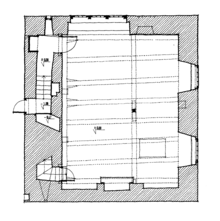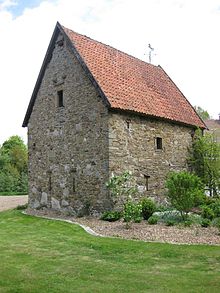Stone work
Stone works (Latin: domus lapidae = stone house), also Kemnate , are a special form of medieval profane architecture . They are frequently the architecture of Romanesque , and the Gothic associate. They are part of an urban architecture, their structural remains are often difficult to recognize in today's cityscape due to recent additions and renovations. In addition to this urban design, stone works can also be found sporadically in rural regions.
The term stone work has already been used in Heliand in the 9th century .
distribution
Stone works are widespread in western and northern Germany , in the former Duchy of Saxony and along the Baltic coast. Stone works (among others) in Dortmund , Münster , Warendorf , Bielefeld , Stadthagen , Cologne , Osnabrück , Ankum , Braunschweig , Goslar , Holtershausen , Brunsen , Bremen , Höxter , Brakel and Minden are still detectable today . The first documented stone works in Lower Germany was built in Osnabrück in 1177. In Osnabrück there are still some well-preserved examples of Romanesque stone works. In Hann. Münden , the Münden stone works was built in the 13th century.
In southern Germany there are no corresponding massive structures, but here the urban residential tower is more prominent.
function
It is likely that stone works were originally built as warehouses and refuge for nobles and patricians . The tower hill castles ( moths ) of the nobility in the countryside were probably used as a model . Often, stone works were retrofitted with additions made of half-timbered , which served as residential buildings .
Construction
The floor plan of the stone works is typically squat rectangular, often almost square. Stone works are mostly multi-storey, often with a basement, often with a vaulted upper floor or several vaulted storeys.
Stone works were built and fortified so that they could be well defended against attacks.
The outer walls are made of solid natural stone or stone , often multi-layered. Wall constructions from 1.00 m to 1.50 m thick up to 2.80 m thick walls are available.
Stone works regularly have a high, defendable entrance.
In Osnabrück, an independent building type has developed since the beginning of the urban stone works. Usually the stone works were built together with a front building. The seven oldest stone works still in existence also have a brick vault under the roof. This version of the Osnabrück stone works was built between the 12th and 14th centuries. Current comparative examples in Germany have not yet been found. The stone roof vault is interpreted as good fire protection. The Ledenhof is a stone work with palas that has shaped the cityscape of Osnabrück to this day . Here the stone works served as a warehouse.
Stone works in their original massive construction were built until the 16th century, after which the massive constructions were gradually reduced.
See also
literature
- Werner Dobelmann : Defense towers in the parish of Ankum ; [1], in: Am heimatlichen Herd - Heimatblatt [19] (1968), No. 2, p. 8; Werner Dobelmann: Defense towers in the parish of Ankum ; [2], in: Heimat-Jahrbuch Osnabrücker Land [7] (1980), pp. 35–39
- Bunse, Jochen / Walberg, Dietmar / Röttrige, Ulla: Dielinger Strasse stone works in Osnabrück - historical building studies. Rastede, Osnabrück 1990
- Michael James Hurst (Ed .: City of Osnabrück - Department of Culture): Steinwerke in Osnabrück - On the trail of the Hanseatic merchants . Osnabrück 2006
- Stone works - a building type of the Middle Ages? , Lectures at the Steinwerke Colloquium from March 2 to 4, 2006 in Osnabrück, (Writings on the archeology of the Osnabrück region, Volume VI), Rasch Verlag Bramsche 2008 ISBN 978-3-89946-110-7
- Bruno Switala: The Osnabrücker Steinwerke , in: Friederichs, A./Igel, K./Zehm, B. (Ed.): From the large stone grave to the Domburg. Research-oriented preservation of monuments in the Osnabrücker Land (International Archeology, Studia honoraria 19), pp. 133–137. Rhaden Westf. 2002
- Ellermann, Nicole / Hurst, Michael James: Steinwerke - One building principle and many functions , homeland yearbook for the Osnabrück region; Pp. 46-53. Belm 2005
Web links
- The Huckinger stone tower in the light of current research, Duisburg monument themes 3 (PDF file; 1.43 MB)
- Photo / interior shot of the stone works at Hasestraße 25-26 in Osnabrück: Restaurant Manolo
- Rural stone works in Osnabrück by CSPrinzhorn
- Stone works and kemenate, Olaf Goldstein, Münster
- High medieval wood and stone buildings in southwest Germany and northern Switzerland, Frank Löbbecke (PDF file; 337 kB)



